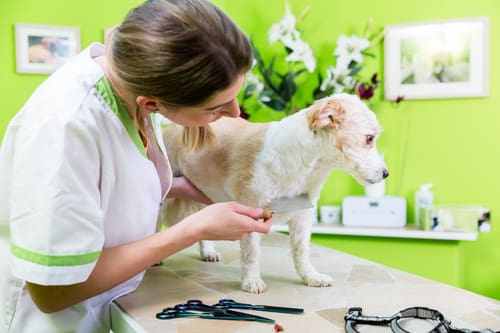Dogs might become scared for several reasons, some of which are rational while others aren’t. Fireworks and thunderstorms are two frequent sources of fear among dogs, but others comprise meeting strangers, separation from owners, and confronting unfamiliar animals or objects.
Indications of fright can range from abrupt flight to physical responses, for instance, whimpering, shaking, and urination. Beware that abrupt behavioral changes might signify a medical issue. Fortunately, our dog grooming school will equip you with the necessary skills to handle a scared dog.
If you’re wondering how to handle a scared dog, perhaps it’s time you enrolled for dog grooming classes in our reputable institution. Here’s a list of techniques you could use to soothe a frightened dog.
 The most powerful thing you could do as a new puppy owner is socializing it. The more experiences your dog acquires, the more comfortable it becomes to trust you and the less fearful he’ll be. Remember, it isn’t too late even if you have an older dog who’s fearful. Start the new experiences in baby steps and early.
For instance, if your dog fears people, start by inviting a friend for an afternoon. Select a room to socialize and bring in your dog with you. Tell your friend to ignore the dog totally and enable him to approach on his timeline.
Like a child, your dog might simply get so wound up or scared that no amount of praise or calming will work. At times, they simply require a quiet space without stimulation where they can just unwind.
The most powerful thing you could do as a new puppy owner is socializing it. The more experiences your dog acquires, the more comfortable it becomes to trust you and the less fearful he’ll be. Remember, it isn’t too late even if you have an older dog who’s fearful. Start the new experiences in baby steps and early.
For instance, if your dog fears people, start by inviting a friend for an afternoon. Select a room to socialize and bring in your dog with you. Tell your friend to ignore the dog totally and enable him to approach on his timeline.
Like a child, your dog might simply get so wound up or scared that no amount of praise or calming will work. At times, they simply require a quiet space without stimulation where they can just unwind.
Socialization and Time Out
 The most powerful thing you could do as a new puppy owner is socializing it. The more experiences your dog acquires, the more comfortable it becomes to trust you and the less fearful he’ll be. Remember, it isn’t too late even if you have an older dog who’s fearful. Start the new experiences in baby steps and early.
For instance, if your dog fears people, start by inviting a friend for an afternoon. Select a room to socialize and bring in your dog with you. Tell your friend to ignore the dog totally and enable him to approach on his timeline.
Like a child, your dog might simply get so wound up or scared that no amount of praise or calming will work. At times, they simply require a quiet space without stimulation where they can just unwind.
The most powerful thing you could do as a new puppy owner is socializing it. The more experiences your dog acquires, the more comfortable it becomes to trust you and the less fearful he’ll be. Remember, it isn’t too late even if you have an older dog who’s fearful. Start the new experiences in baby steps and early.
For instance, if your dog fears people, start by inviting a friend for an afternoon. Select a room to socialize and bring in your dog with you. Tell your friend to ignore the dog totally and enable him to approach on his timeline.
Like a child, your dog might simply get so wound up or scared that no amount of praise or calming will work. At times, they simply require a quiet space without stimulation where they can just unwind.
Training and Distraction
Bear in mind that regardless of the amount of socialization and training your dog attains, some animals scare easily than others. Nevertheless, the appropriate measures will help your dog decrease anxiety. In certain situations such as thunderstorms scare your dog, distraction could work. Engaging the dog’s brain will help him concentrate on you and the things he’s familiar with. Try rewarding the dog with basic treats for simple commands like lying down, standing, or sitting up. Another possibility for food-motivated dogs is distracting them with puzzle toys, which can help the dog link frightening things such as loud noises to valued rewards. This way, the dog will shift from being scary too at least tolerable.Relaxing Massage
Everybody enjoys a relaxing massage and the same applies to our pets. Massage can help cool a scared dog through long and slow strokes to sooth the nerves. A popular massage technique is TTouch-a technique based on circular movements of the hands produced by Linda Tellington Jones. The goals of this method are activating the cells’ function and awakening cellular intelligence. The outcome is a relaxed dog. Moreover, studies indicate that petting your dog can help relax your nerves, so it’s a win-win situation. You can easily find guides on how to massage it to help soothe your pet.Dog-calming music and Calm Demeanor
We aren’t the only species that can experience calmness through soothing music. Numerous owners leave a radio or television on when they leave the home to help the dog feel comforted. However, there’s specialized music aimed at soothing scared or nervous dogs. The music can help during various circumstances like travel and separation anxiety. You’ll even find compilations that seek to help desensitize your pet with noise phobias. While music has the ability to calm the dog, specific kinds might help soothe dogs even more efficiently.
The music can help during various circumstances like travel and separation anxiety. You’ll even find compilations that seek to help desensitize your pet with noise phobias. While music has the ability to calm the dog, specific kinds might help soothe dogs even more efficiently.
Sign up for
Free Career Report
"*" indicates required fields
By clicking SUBMIT, I consent to receive telephone calls and text messages from Merryfield Academy at the number above with information about their programs. I understand that the calls and messages may be initiated with automated equipment and that I am not required to provide this consent to be eligible to (enroll/apply).
